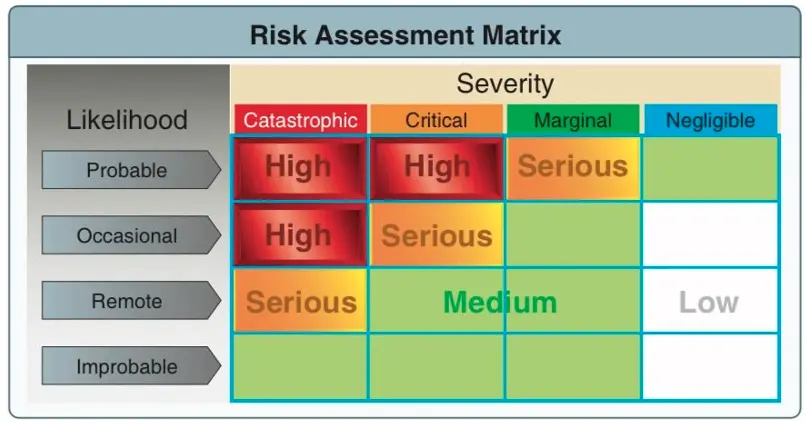During every flight, a solo-flying pilot makes numerous decisions under hazardous conditions. Hazards must be assessed and assigned a degree of risk in order to determine the best course of action and prevent hazards from turning into catastrophic risks.
Assessing risks as a single pilot is both critical and complicated, since there are no other crew members serving as quality control when it comes to risk assessment. For example, a fatigued single pilot may have flown 8 hours solo in a day and decide to keep flying. Many pilots are goal-oriented and when asked, or when anxious to accept or complete a flight, may do so under less than ideal circumstances. Personal limitations must be taken into account whenever a pilot feels a sense of urgency or obligation to complete a flight.
The Risk Assessment Matrix is used when assessing risk; it's a helpful tool when evaluating the likelihood and severity of an event.

Likelihood of an event
Determining the likelihood of an event is taking a situation and determining the probability of its occurrence. There are four ways to rate the likelihood of an event. The following are guidelines for rating the likelihood of an event:
- Probable—an event will occur several times
- Occasional—an event will probably occur sometime
- Remote—an event is unlikely to occur, but is possible
- Improbable—an event is highly unlikely to occur
Severity of an event
Determining the severity of an event is taking a situation and evaluating the consequences of a pilot’s actions. The consequences could be injury to self and/or passengers, damage to aircraft or property, etc. The following are guidelines for rating the severity an event:
- Catastrophic—results in fatalities, total loss
- Critical—severe injury, major damage
- Marginal—minor injury, minor damage
- Negligible—less than minor injury, less than minor system damage
Determining the likelihood and severity of an event using the Risk Assessment Matrix indicates whether the risk is low, medium, or severe, and is useful to the pilot in determining whether or not to fly.
There are more comprehensive risk assessment worksheets that can even be tailored to the individual pilot and contain more specific assessments such as pilot health or fatigue, weather, aircraft and pilot capabilities, etc.
By Engine Sales Representative, Joshua Denton
[Editor’s Note]: Image taken from the FAA Pilot’s Handbook of Aeronautical Knowledge.
YOU MAY ALSO LIKE:
Understanding the Aircraft Spark Plug - When it comes to the intricate machinery of aircraft engines, even the smallest components play a crucial role.
A Pilot's Guide to Pre-Flight Checks - This guide provides an in-depth exploration of the nuances and intricacies of pre-flight inspections, empowering you to perform them with absolute confidence.
Pilot Certifications Part 1: Sport Pilot Certificate - Each type of pilot certificate has different eligibility, training, experience, and testing requirements.
*SHOP ENGINE PARTS HERE!*
Find What You Need at Air Power Inc.!
Questions? Our team is ready to assist you anytime. Your aviation success starts at Air Power!
CONTACT US






